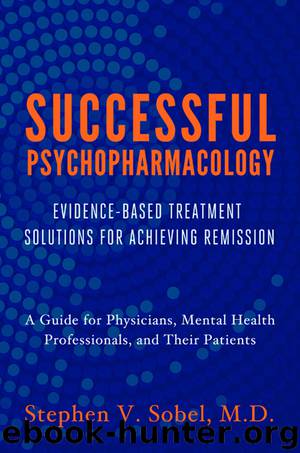Successful Psychopharmacology by Stephen V. Sobel

Author:Stephen V. Sobel
Language: eng
Format: epub
Publisher: W. W. Norton & Company
Published: 2012-08-21T16:00:00+00:00
TREATING BULIMIA
What causes your patient to eat essentially everything in the refrigerator then, after vomiting, seek out more food? What causes her to exercise hours per day to try to stay thin? How can a person abuse diet pills and laxatives in an endless search for the perfect body? How can her self-esteem be so determined by her appearance? What can we do about it? Work with patients suffering from bulimia is incredibly challenging. Eating disorders are perplexing.
The hallmark of bulimia is the binge and purge. A binge consists of the consumption of a large amount of food in a short period of time, usually secretly and alone. The key is that it occurs with a loss of control and is followed by self-loathing, anger, and compensatory behaviors such as purging. Purging presents in a variety of forms, including vomiting or the abuse of laxatives, diuretics, or diet pills. It may include restricting and exercise abuse. There is preoccupation with body size and shape. Patients’ self-evaluation and self-esteem are unduly influenced by their body size and weight.
A related disorder is binge eating disorder (BED). Patients who have BED engage in binge behavior but do not purge. How do we differentiate binge eating from simply eating too much and from obesity? The key is that there is a lack of control during bingeing. A lot of food is consumed in a short period of time. Binges occur as a way of dealing with feelings. DSM-IV-TR defines BED as bingeing twice weekly for 6 months with marked distress, guilt, shame, and self-abuse. Individuals who simply eat too much all day along are not suffering from a DSM-IV-TR eating disorder. They have obesity. It is important to differentiate these disorders, since the treatments are significantly different. The treatment of bulimia and BED are very similar and differ significantly from the treatment of obesity.
What Causes Bulimia?
Bulimia and anorexia nervosa are quintessential biopsychosocial disorders. Successful psychopharmacologists recognize that treatment must therefore be multifocal to address the multiple factors involved in the development of bulimia. Treatment with medications is an integral and important part of this overall treatment strategy. However, an attempt to treat a woman suffering from bulimia with medications alone will inevitably fail. Treatment must not rely just on the use of medications.
Many factors are involved in the development of bulimia, including psychodynamic, cognitive, behavioral, social, family, and biological factors. Early psychodynamic theories conceptualized the binge as the girl’s symbolic attempt at oral impregnation by her father followed by the angry repudiation of this desire through purging. It’s okay to laugh at this concept. Needless to say, psychodynamic psychotherapy alone does not effectively treat bulimia.
Other psychological factors including cognitive and behavioral factors are, however, involved in the etiology of this disorder. Social factors are involved. Society overly values men by their status and achievement, often measured by the size of their bank accounts, and women based upon their appearance, often measured by the size of their bodies. Fortunately, as gender roles and expectations change these valuations change with them, but true vacuums exist only in outer space.
Download
This site does not store any files on its server. We only index and link to content provided by other sites. Please contact the content providers to delete copyright contents if any and email us, we'll remove relevant links or contents immediately.
The Poisoner's Handbook by Deborah Blum(1980)
Bottle of Lies by Katherine Eban(1705)
Mycelium Running: How Mushrooms Can Help Save the World by Paul Stamets(1579)
The Vaccine Race by Meredith Wadman(1563)
Missing Microbes by Martin Blaser(1519)
Pharmacy Practice and The Law by Richard Abood(1495)
The Doors of Perception and Heaven and Hell by Aldous Huxley & Aldous Huxley(1490)
Decisive by Chip Heath(1457)
Steroids: History, Science, and Issues by Standora Joan E.; Bogomolnik Alex; Slugocki Malgorzata(1427)
28 Seconds by Michael Bryant(1421)
The Doors of Perception: Heaven and Hell (thINKing Classics) by Aldous Huxley(1412)
McGraw-Hill Nurses Drug Handbook by Patricia Schull(1399)
Ganja Yoga by Dee Dussault(1385)
What's Making Our Children Sick? by Michelle Perro(1350)
Complete Guide to Prescription & Nonprescription Drugs 2014 by H. Winter Griffith(1282)
Stealing Fire: How Silicon Valley, the Navy SEALs, and Maverick Scientists Are Revolutionizing the Way We Live and Work by Steven Kotler & Jamie Wheal(1276)
Anatomy of an Epidemic by Robert Whitaker(1237)
Trip by Tao Lin(1234)
Cannabis for Chronic Pain by Rav Ivker(1166)
